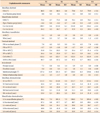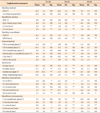1. Bos A, Hoogstraten J, Prahl-Andersen B. On the use of personality characteristics in predicting compliance in orthodontic practice. Am J Orthod Dentofacial Orthop. 2003; 123:568–570.

2. Story RI. Psychological issues in orthodontic practice. Am J Orthod. 1966; 52:584–598.

3. El-Mangoury NH. Orthodontic cooperation. Am J Orthod. 1981; 80:604–622.

4. Sahm G, Bartsch A, Witt E. Micro-electronic monitoring of functional appliance wear. Eur J Orthod. 1990; 12:297–301.

5. Cureton SL, Regennitter FJ, Yancey JM. Clinical versus quantitative assessment of headgear compliance. Am J Orthod Dentofacial Orthop. 1993; 104:277–284.

6. Pancherz H. The mechanism of Class II correction in Herbst appliance treatment. A cephalometric investigation. Am J Orthod. 1982; 82:104–113.
7. Schiavoni R. The Herbst appliance updated. Prog Orthod. 2011; 12:149–160.

8. Pangrazio-Kulbersh V, Berger JL, Chermak DS, Kaczynski R, Simon ES, Haerian A. Treatment effects of the mandibular anterior repositioning appliance on patients with Class II malocclusion. Am J Orthod Dentofacial Orthop. 2003; 123:286–295.

9. Ghislanzoni LT, Toll DE, Defraia E, Baccetti T, Franchi L. Treatment and posttreatment outcomes induced by the Mandibular Advancement Repositioning Appliance; a controlled clinical study. Angle Orthod. 2011; 81:684–691.

10. Jasper JJ, McNamara JA Jr. The correction of interarch malocclusions using a fixed force module. Am J Orthod Dentofacial Orthop. 1995; 108:641–650.

11. Küçükkeleş N, Ilhan I, Orgun IA. Treatment efficiency in skeletal Class II patients treated with the jasper jumper. Angle Orthod. 2007; 77:449–456.

12. Stromeyer EL, Caruso JM, DeVincenzo JP. A cephalometric study of the Class II correction effects of the Eureka Spring. Angle Orthod. 2002; 72:203–210.
13. Bowman AC, Saltaji H, Flores-Mir C, Preston B, Tabbaa S. Patient experiences with the Forsus Fatigue Resistant Device. Angle Orthod. 2013; 83:437–446.

14. Jones G, Buschang PH, Kim KB, Oliver DR. Class II non-extraction patients treated with the Forsus Fatigue Resistant Device versus intermaxillary elastics. Angle Orthod. 2008; 78:332–338.

15. Franchi L, Alvetro L, Giuntini V, Masucci C, Defraia E, Baccetti T. Effectiveness of comprehensive fixed appliance treatment used with the Forsus Fatigue Resistant Device in Class II patients. Angle Orthod. 2011; 81:678–683.

16. Aras A, Ada E, Saracoğlu H, Gezer NS, Aras I. Comparison of treatments with the Forsus fa-tigue resistant device in relation to skeletal maturity: a cephalometric and magnetic resonance imaging study. Am J Orthod Dentofacial Orthop. 2011; 140:616–625.

17. Gunay EA, Arun T, Nalbantgil D. Evaluation of the immediate dentofacial changes in late adolescent patients treated with the Forsus(™) FRD. Eur J Dent. 2011; 5:423–432.
18. McNamara JA Jr. Early intervention in the transverse dimension: is it worth the effort? Am J Orthod Dentofacial Orthop. 2002; 121:572–574.

19. Baccetti T, Franchi L, McNamara JA. The cervical vertebral maturation (CVM) method for the assessment of optimal treatment timing in den-tofacial orthopedics. Semin Orthod. 2005; 11:119–129.

20. Steiner CC. Cephalometrics for you and me. Am J Orthod. 1953; 39:729–755.

21. Jacobson A. The "Wits" appraisal of jaw disharmony. Am J Orthod. 1975; 67:125–138.

22. Ricketts RM. Perspectives in the clinical application of cephalometrics. The first fifty years. Angle Orthod. 1981; 51:115–150.
23. McNamara JA Jr. A method of cephalometric valuation. Am J Orthod. 1984; 86:449–469.
24. Shroff B, Lindauer SJ. Leveling and aligning: Challenges and solutions. Semin Orthod. 2001; 7:16–25.

25. Phan KL, Bendeus M, Hägg U, Hansen K, Rabie AB. Comparison of the headgear activator and Herbst appliance-effects and post-treatment changes. Eur J Orthod. 2006; 28:594–604.

26. Aslan BI, Kucukkaraca E, Turkoz C, Dincer M. Treatment effects of the Forsus Fatigue Resistant Device used with miniscrew anchorage. Angle Orthod. 2014; 84:76–87.

27. Pancherz H, Anehus-Pancherz M. The headgear effect of the Herbst appliance: a cephalometric long-term study. Am J Orthod Dentofacial Orthop. 1993; 103:510–520.








 PDF
PDF ePub
ePub Citation
Citation Print
Print


 XML Download
XML Download